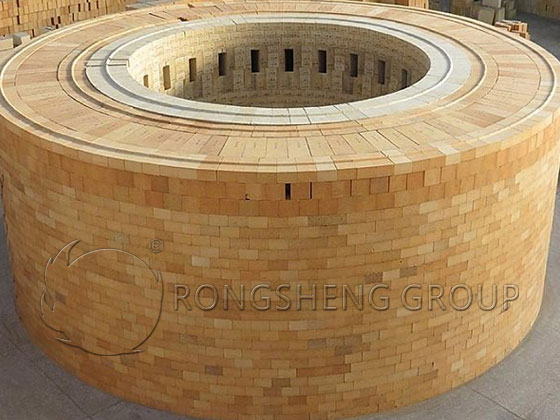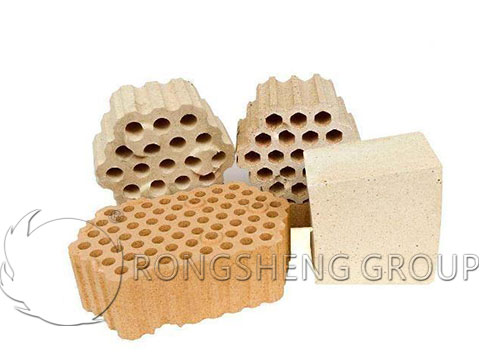The selection of refractory materials for hot blast stoves is mainly determined by the temperature of the hot blast. When the wind temperature is lower than 900°C, clay bricks are generally used, and their service life can reach about 20 years. When the air temperature is between 900 and 1100°C, high-alumina bricks, mullite bricks, or sillimanite bricks are used for the furnace lining and checker bricks in the high-temperature part. When the air temperature is higher than 1100°C, high alumina bricks, mullite bricks, and silica bricks are generally used as furnace lining or checker bricks.
In recent years, newly built or renovated blast furnace hot blast stoves in various countries mainly adopted external combustion type. The supply air temperature is 1200~1350℃, and the vault temperature is generally 1500~1550℃, even close to 1600℃. Therefore, the high-temperature parts of the furnace lining and the upper layer of checker bricks are generally constructed with silica bricks, which has better results.

What is the Alumina Content of High-Alumina Refractory Bricks Used in Hot Blast Stoves?
Regarding the high alumina refractory bricks with alumina content used in a new hot blast stove, it is generally recommended to choose high alumina refractory bricks with higher alumina content. High-alumina refractory bricks usually have an alumina content between 48% and 80%, which can provide better fire resistance and corrosion resistance.
The use of high alumina bricks in the medium temperature zone and high and low temperature alternating zones of hot blast furnaces.
The medium temperature area of the hot blast stove (600~1150℃) refers to the middle part of the flame in the combustion chamber, and in the regenerative type it refers to the middle part of the checker bricks, the transition section from high temperature to low temperature. In this area, low creep high alumina bricks or high-grade andalusite bricks are generally selected. For internal combustion and external combustion hot blast stoves, the area from the top of the burner to the vicinity of the hot blast outlet. As well as the top-fired hot blast stove, the space enclosed by the inner wall of the burner – the pre-combustion chamber, is a high and low temperature alternating area (35~1100℃). The temperature changes in this area are mainly caused by the mutual conversion of the “combustion-air supply” cycle of the hot blast stove. It is advisable to choose andalusite or cordierite bricks with good thermal shock resistance.
The hot air ducts of hot air stoves are also traditionally made of andalusite bricks. In recent years, with the increase in wind temperature, refractory bricks using andalusite-mullite composite have also appeared.

There are many types of high alumina bricks, and their properties vary greatly depending on the Al2O3 content and crystal form.
- Low creep high alumina bricks
The main characteristic of low creep high alumina bricks is their good creep resistance. Domestic production of low creep high alumina bricks generally uses bauxite as the main raw material. The “three stone” minerals (andalusite, sillimanite, and kyanite) are additives. Among the “three stone” minerals, the addition of andalusite is more common.
Adding tristone to solve the creep resistance problem of high-alumina products lies in the final mulliteization of tristone. During the firing process of high alumina bricks, the three stones will undergo mullite formation, and the reaction will directly generate mullite. The accompanying SiO2 will react with high-alumina materials again, causing secondary mulliteization. After the final firing is completed, the three stones in the crystal phase will be completely converted into mullite, and n(Al2O3)/n(SiO2) is close to 3:2, forming a stable columnar mullite crystal phase structure. This structure determines that high alumina bricks have good creep resistance.
- Andalusite bricks
Andalusite bricks have good high-temperature properties, and their high-temperature creep resistance is better than high-alumina bricks and most mullite bricks. Moreover, the volume expansion associated with high-temperature mullite formation is small, and it has good thermal shock resistance. It is an ideal low-creep refractory material.
The main raw material used in the production of andalusite bricks is andalusite, and the proportion is generally higher than 40%. If it is made into andalusite-mullite composite brick, a part of mullite or corundum should also be added. If the mullite raw material is synthetic mullite. The crystals should be thicker to reduce the number of grain boundaries, weaken the slip of the crystals at high temperatures, and enhance the creep resistance of the bricks.
- Cordierite bricks
The linear expansion coefficient of cordierite bricks is small. The linear expansion coefficient at 20~900℃ is (1.25~1.92)×10-6℃-1, and it has good thermal shock resistance. However, the refractoriness of cordierite is low, only 1370℃. When the firing temperature is too high, a glass phase is easily produced. Pure cordierite bricks cannot be well used in high and low-temperature alternating areas due to their low operating temperature range. In actual production applications, cordierite is often added as an auxiliary raw material, which has a significant effect on improving the thermal shock resistance of bricks.

